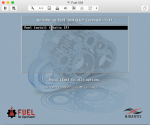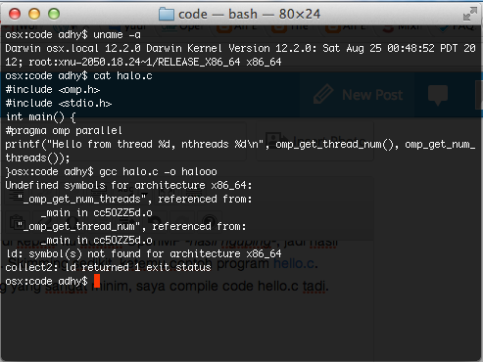I would like to express my gratitude to everyone who help me finishing my diploma thesis. I would prefer writing it in Bahasa Indonesia.
Alhamdulillah, segala puji bagi Alloh Azza wa Jalla, Tuhan sekalian alam yang khususnya telah mengizinkan saya untuk menyelesaikan tugas akhir saya ini dan mendapatkan gelar sarjana teknik elektro.
Ayah, Ibu, Mas dan Mbak dan Dek Mita, keluarga yang selalu ada, penuh cinta dan penuh keceriaan. Matur nuwun…
Terima kasih saya ucapkan kepada Pak Eueung Mulyana sebagai pembimbing saya yang telah memberikan saya kesempatan untuk mengerjakan tugas akhir di bawah bimbingan beliau. Tanpa beliau, mungkin saya tidak bisa menyelesaikan tugas akhir saya ini. Nuhun atas diskusi-diskusinya pak..Terima kasih juga kepada Pak Hendrawan sebagai pembimbing 1 yang disela-sela sibuknya, masih bisa saya temuin untuk diminta tanda tangannya. Makasih pak…
Terima kasih juga saya ucapkan untuk Pak Soehartono, Pak Soegihartono dan Ibu Chairunnisa sebagai tim penguji sidang tugas akhir saya. Saya pikir dapat 90, tp 80 itu sudah lebih dari cukup buat saya kok pak, bu 😉
Kemudian, saya ucapkan terima kasih kepada Om Basuki Suhardiman yang telah mengizinkan saya untuk mengambil data dari jaringan ITB. Terima kasih juga buat teman-teman di CNRG : Mas Wahyu Hidayat dan Mas Affan Basalamah atas diskusi-diskusinya tentang jaringan ITB. Kemudian juga buat Mas Rendo Ariya Wibawa dan Mas Achmad Husni Thamrin, yang telah bersedia berdiskusi dan menjawab pertanyaan-pertanyaan bodoh saya tentang Interdomain routing dan BGP. Ah. hampir lupa ! Juga buat Galih yang udah nyediain data netflow. Makasih, Gal !
Buat Igun, makasih banyak atas diskusi-diskusinya, bantuannya bikin grafik pake Excel 2007 sori, aku saiki biasa nganggo Ooo :p dan atas bolehnya nge-print pake printer TI yang keren :D. I owe you, dude !
Matur suwun buat Bos Halim, owner Cibuku.com yang telah membantu saya debugging perl script yang saya buat.
Many thanks goes to Dr. Bruno Quoitin, author of C-BGP, whom very kind discussing about Interdomain Routing and C-BGP with me.
Terima kasih buat temen-temen ARC khususnya angkatan cap-cay : Domplenk, Anto, Aris Dolop, Alex, Azi, Alfa, Jaya, Andi, Igun, Tiko. Friendship lasts forever..
Terima kasih juga buat teman-teman seperjuangan di Lab Telematika ITB : Adit, Boma cepet lulus guys !, Mata, Rizal, Panji, Budi, Ronald, dan banyak lagi yg sering nongkrong di Lab Telmat. Terima kasih juga untuk kawan-kawan seperjuangan di kost sadang serang : Dana genki desu ka ?, Uzan how’s s’pore?, Toha, Bambang kapan kawin?, Evan selamat berjuang kangmas !, Megi, Ishan, Deva, Ichwan, Wawan ojo CS-an terus, rek !; tetangga satu RW : Dea, Miftah, Wiwit, Rian wis nang CNOOC yo ? selamat !, Sahal, Irawan. Buat yang baru pulang dari negeri antah berantah , Tiko, matur nuwun, dab.
Saya juga ingin mengucapkan terima kasih buat direksi dan karyawan LAPI ITB, tempat saya “menyambung hidup” bekerja paruh waktu jadi admin jaringan. Nuhun bapak-bapak..ibu-ibu…
Terima kasih juga buat temen-temen di milis el02(at)itb.ac.id, kapan jadi numero uno ?. Temen-temen di TJAKRA(at)yahoogroups.com, tahun ini ada syawalan ?
Last but not least, to my luph, Lani, yang dengan penuh kesabaran dan kasih sayang 🙂 menemani hari-hari penuh perjuangan kemaren, saat ini dan semoga-insya ALLOH- hari-hari penuh perjuangan di masa depan.
Semoga tugas akhir saya ini dapat bermanfaat. Dan tunggu kelanjutannya akhir tahun ini, insya ALLOH !
Bandung, Sep 26 2007
—
-adhy
PS : ini bukan format resmi dalam buku tugas akhir :p





















